Archive for category January 2019
A Pearl of Wisdom on Interpersonal Relationships from Ouvaiyaar, the Grandmotherly Tamil Poet
Posted by admin in January 2019, Past issues on January 24, 2019
Ouvvaiyaar is a legendary— even mythical — poet in Tamil literature. With the name meaning in Tamil “The respectable Old Lady,†one can imagine the exalted place her name occupies among Tamils, scholars and commoners alike. Literary historians believe that more than one person went by the name. For example, there was one Ouvvaiyaar in the Sangam Period (2nd century BC to 2nd century AD), and one in the 10th century.
They conclude this after carefully analyzing the phrases and vocabulary used in the literary works attributed to the Poetess Ouvvaiyaar.
From her literary works, we learn that he was a Saivite, grandmotherly, austere mendicant, full of wisdom on the way of the world. Her message transcends time, place and cultures.
Here is one of her pearls of wisdom, on what we call today interpersonal relationships today, first in Tamil, in the meter of Vennbaa. :

Here is the non-literary translation:
Rice paddy is threshed to get rice grains. The husk is discarded.
Without the husk intact in the paddy seed, though, it never can germinate.
No matter how intelligent, strong and capable a person is,
Without critical subordinate help, one accomplishes nothing.
Here is a great lesson on interpersonal relationships for ambitious and aggressive MBA students and other graduating seniors who will be starting their careers making big bucks while managing other people’s resources and assets in corporations.
This is also a good advice for doctors, engineers, lawyers, managers and business owners, who are in great haste trying to climb their career ladders and amass wealth, not paying attention to how they trample on their colleagues and subordinates.
Till even 70 years ago, Tamil alphabets in schools were taught using Ouvvaiyaar’s works, Aathi-choodi and Kondrai-vendan. In these, each alphabet was vocalized — like a for Apple, b for biscuits, c for cat in English – but with this major difference: Each Tamil alphabet – like a aa, e, ee, u uu… – was elaborated with an advice starting with that alphabet, that conveyed codes of conduct, such as “Be 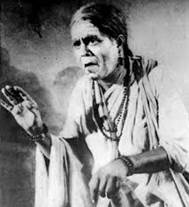 charitableâ€, “Be helpfulâ€, “Control your temperâ€,  “Don’t give up efforts†… …  In today’s teaching of Tamil in elementary schools, these are completely gone.
charitableâ€, “Be helpfulâ€, “Control your temperâ€,  “Don’t give up efforts†… …  In today’s teaching of Tamil in elementary schools, these are completely gone.
She is so popular among the Tamils that decades ago they made a popular play on Ouvvaiyaar, with T K Shanmugam (see the picture on above), a male actor, playing the role of Ouvvaiyaar. A black-and white film was made with the famous K B Sundarambal playing the role of Ouvvaiyaar.
— By K  S  Venkataraman
Home:
Celebrate Every New Moment as a Providential Gift, Not Just January 1… …
Posted by admin in January 2019, Past issues on January 24, 2019
Natyakriya Celebrates Ten Years
Posted by admin in January 2019, Past issues on January 19, 2019
By Srujana Kanjula, Wexford, PAÂ Â Â Â Â Â Â Â Â srubru@rediffmail.com
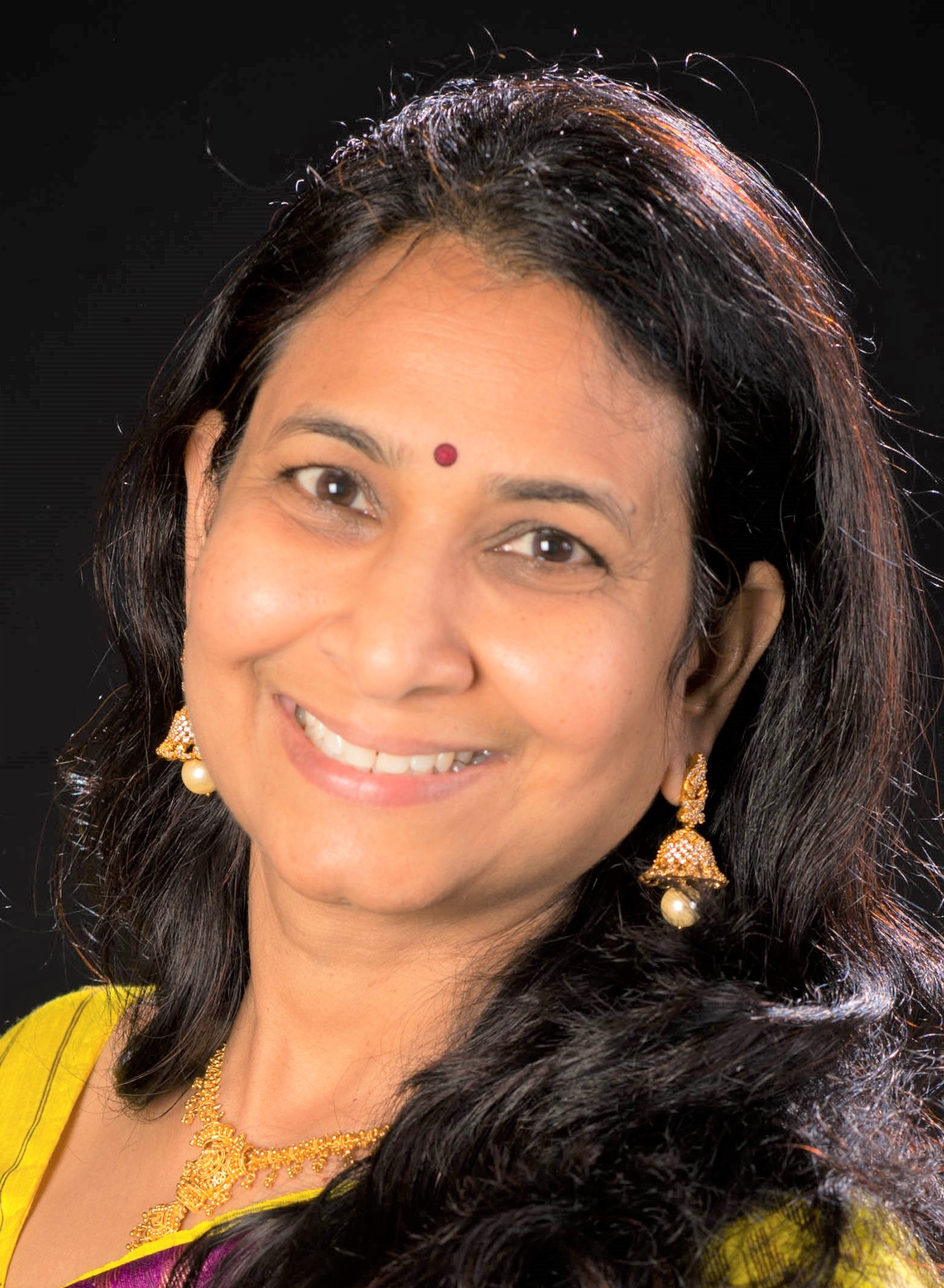 Editor’s Note: Srujana (picture on the side) was born in Tirupathi and had her schooling at Anantapur, in Andhra Pradesh. After her MA in Political Science from Hyderabad Central University, she completed her MPhil and PhD from Jawaharlal Nehru University (JNU), New Delhi. She teaches political science and sociology at the Community College of Allegheny County (CCAC) at North Campus, and lives in Wexford, PA.
Editor’s Note: Srujana (picture on the side) was born in Tirupathi and had her schooling at Anantapur, in Andhra Pradesh. After her MA in Political Science from Hyderabad Central University, she completed her MPhil and PhD from Jawaharlal Nehru University (JNU), New Delhi. She teaches political science and sociology at the Community College of Allegheny County (CCAC) at North Campus, and lives in Wexford, PA.
The founder of the dance school Natyakriya, Shobhitha Ravi (picture below), with fifteen of  her students, presented the dance program, Sri Vidya Shakti, on October 6, 2018, at North Hills Middle School, celebrating ten years of teaching Bharatanatyam. The theme of the production Sri (wealth), Vidya (knowledge) and Shakti (strength) was in praise of Devi, the universal mother in Hinduism. The program coincided with the Navaratri festival in which Hindus celebrate Devi in the form of Lakshmi (Sri), Saraswati (Vidya) and Parvathi (Shakti).
her students, presented the dance program, Sri Vidya Shakti, on October 6, 2018, at North Hills Middle School, celebrating ten years of teaching Bharatanatyam. The theme of the production Sri (wealth), Vidya (knowledge) and Shakti (strength) was in praise of Devi, the universal mother in Hinduism. The program coincided with the Navaratri festival in which Hindus celebrate Devi in the form of Lakshmi (Sri), Saraswati (Vidya) and Parvathi (Shakti).
The program was divided into three sections, each focusing on one theme with the dancers in traditional bright costumes performing three items in each section. The young dancers were good with abhinaya, a coordinated combination of movements of the legs and footwork and hand gestures to rhythmic music and facial expressions, all to convey stories.
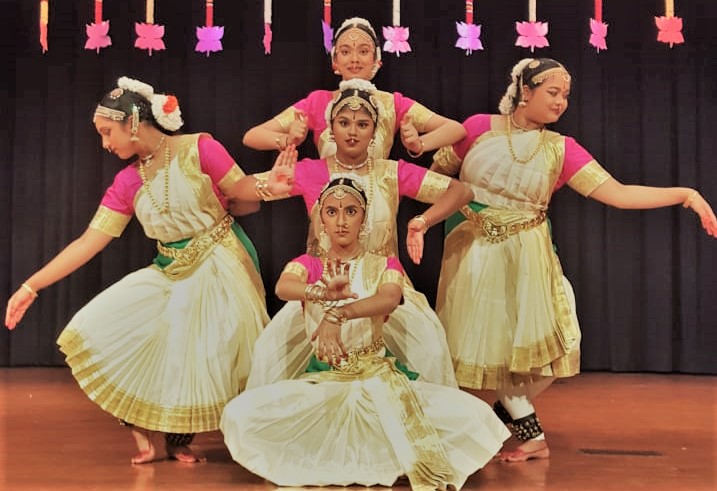
Akshara Murali, Bhavana Kolla, Jothika Gorur, Nanditha Ganesan, and Malini Harinath.
It was a ticketed event, with all the proceeds benefiting EKAM USA Foundation, a non-profitorganization committed to providing healthcare to needy babies and mothers in India to reduce the mortality of mothers & infants at child birth.
The program was a success with good attendance helping a social cause. Shobhitha’s solo dance was impressive and her students were energetic, enthusiastic, and talented. Their hard work and love for dance was evident throughout. The master of ceremonies, Sandhya Rao, impressed the audience, describing the dance pieces and relating them meaningfully to the nine-day Navaratri celebrations. Carol Schneider, the World Languages teacher at Shady Side Academy Senior School aptly remarked, “The dances were stunningly beautiful and exquisitely choreographed. The movements, the music, and bright costumes combined to make the experience enchanting and enriching.â€
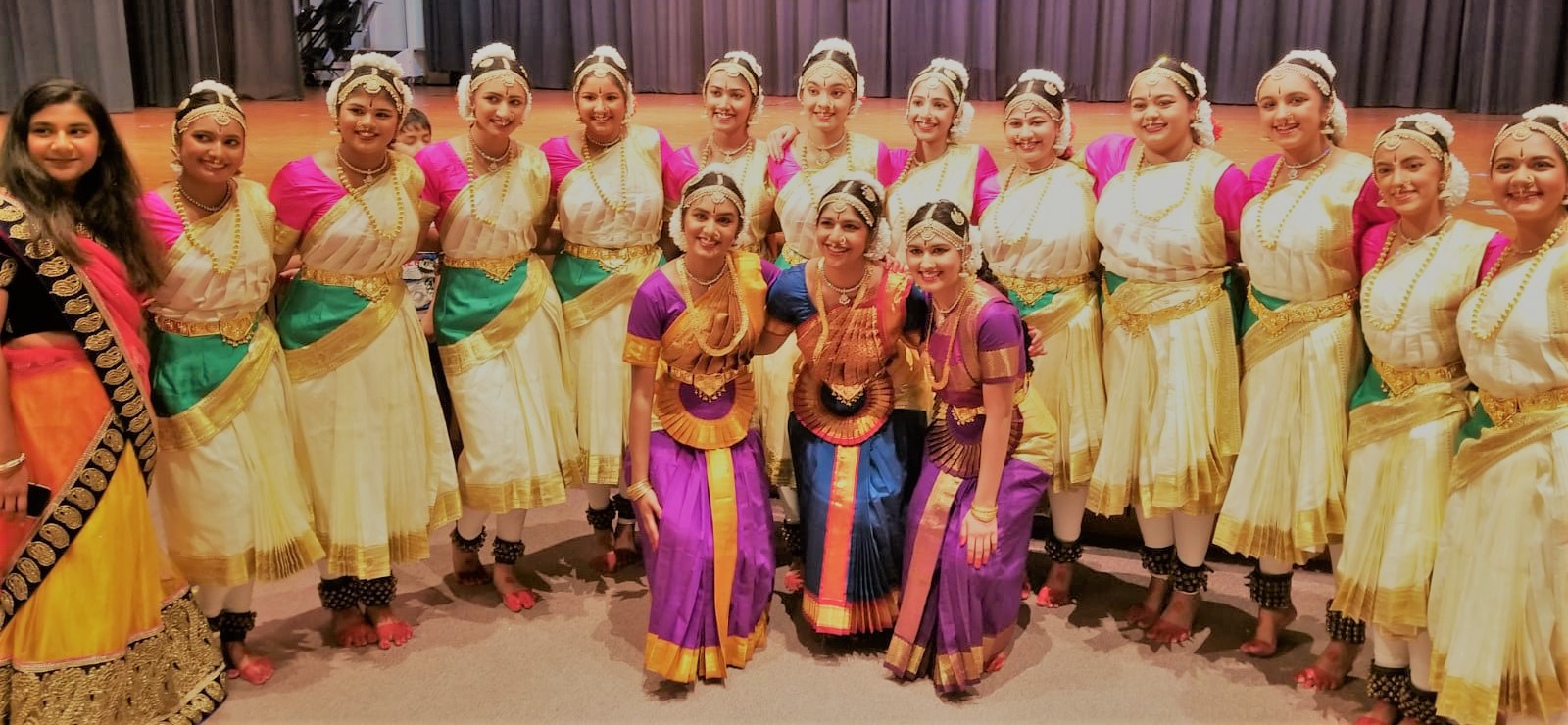
L to R Top: Somya Thakur, Sherin Puthenpurayil, Bhavana Kolla, Mitali Belambe, Meghana Vemulapalli, Sruthy Miriyala, Malini Harinath, Sanjana Harish, Kavya Balakumar, Nanditha Ganesan, Akshara Murali, Jothika Gorur, Anagha Arunkumar. Bottom: Keerthana Samanthapudi, Harsha Mikkilineni, Inu Miriyala.
Natyakriya, founded in 2008, strives to preserve and spread Indian art and culture here. From a small base of eighteen students, the school now has over 100 students. Over the years, ten students have completed their arangetram under Shobhitha, a disciple of Natyakalavathi Jaya Mani, who trained Shobhitha in the Kancheepuram Ellappa Pillai tradition.
With a passion for dance and patience, Shobhitha mentors and inspires her students. We wish her well for continued success in the years ahead in teaching Bharatanatyam and touching the lives of many children and parents in such a profound manner. ♠
Home:
The ‘Burgh’s Brand New Organization for Seniors
Posted by admin in January 2019, Past issues on January 19, 2019
By Arun D. Jatkar, Monroeville, PAÂ Â Â Â Â Â Â Â Â Â ajmarathi@yahoo.com
Founded by Pittsburgh’s senior citizens to serve the interests of Pittsburgh’s senior citizens and open to all senior citizens regardless of creed, color and country of origin, here is the United Seniors Association of Pittsburgh (or USAP for short).
USAP was founded in December 2017 and registered as a non-profit organization in the Commonwealth of Pennsylvania. It has also received approval as a tax-exempt 501(c)(3) charitable organization from the U.S. Internal Revenue Service.
USAP’s mission statement reads:
To promote healthy aging through education, participation and social support, and thus, dignity, independence and longevity of its members in their senior years; and provide a forum that would encourage able seniors to help fellow seniors in need, with goal to minimize their dependence on society.
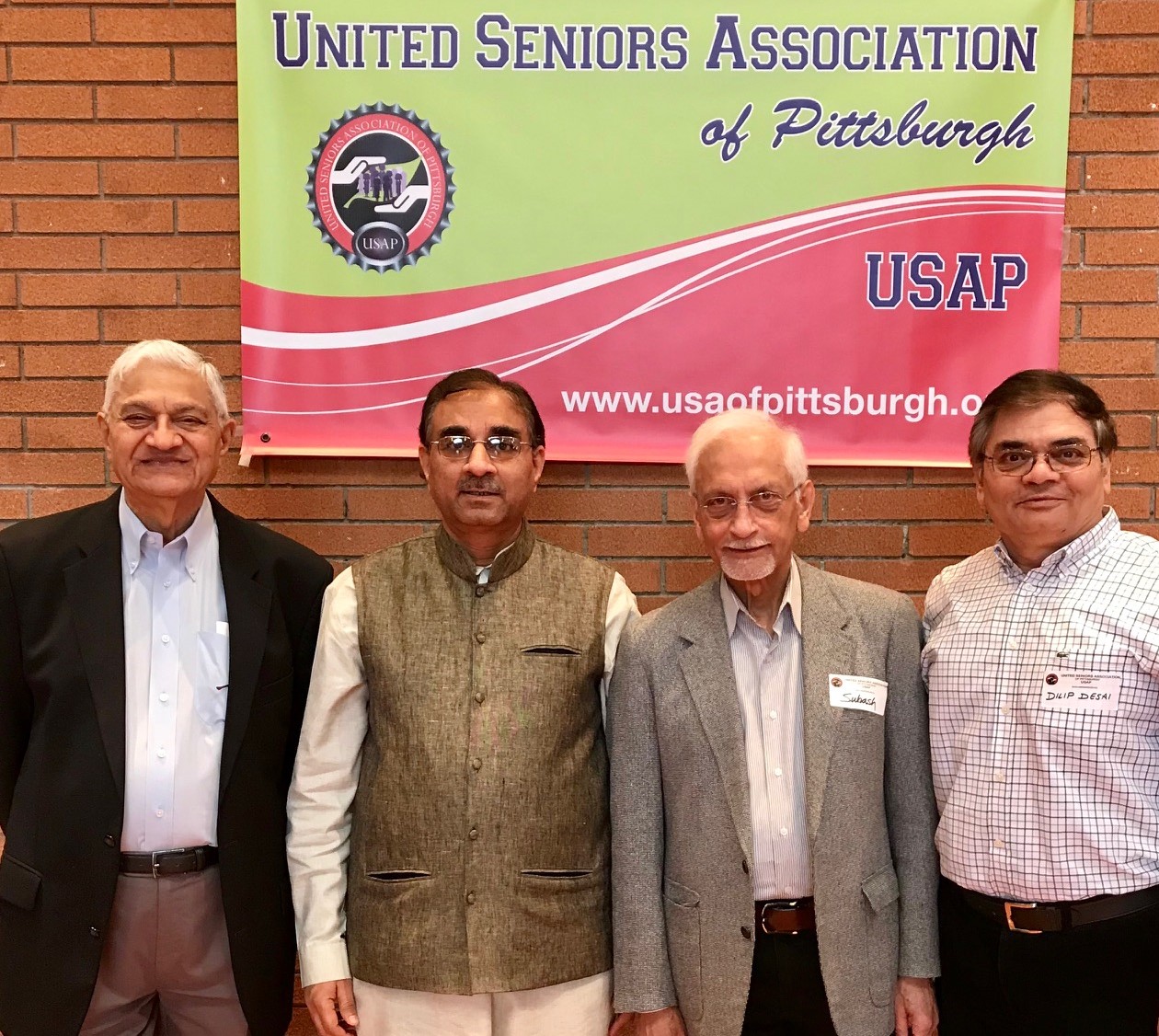
Current office holders L to R: Rajnikant Popat, Chetan Patel, Subash Ahuja, and Dilip Desai.
Two hundred and forty-two senior citizens of Pittsburgh have already become members of this rapidly growing organization. This includes 31 life-time charter members.
USAP members are vibrant professionals from all walks of life — doctors, engineers, computer specialists, teachers, businessmen, entrepreneurs — with wide interests and passions on diverse topics.
During 2018, its first year of operation, USAP organized fourteen well-attended, well-received informative and entertaining events. These included, among others, informative talks by professionals on healthy aging and financial and social wellbeing. Topics included :
- Yoga & meditation, physical fitness,
- Ayurvedic approach to healthy eating and living,
- New tax laws affecting senior citizens,
- Health insurance, protection of personal identity,
- A music gala, a bowling bash, introduction to bridge and other card games, a golf outing, and
- A three-week organized tour of eastern Europe!
One might think that all this must amount to a big fat membership fee that a middle-class senior living off his or her limited life savings and Social Security income can only dream of. Nothing could be further from the truth! Now get this: It is only $30 per person for 2019. This number was at the insistence of the all members because refreshments and snacks are served free of charge at these events. Beverages like tea and coffee are always on the house at all events. And one could go for Charter Membership by paying only $ 500 per person.
Organizationally, four officers run USAP: Mr. Chetan Patel (President), Mr. Dilip Desai (Vice President), Dr. Subash Ahuja (Secretary) and Dr. Rajnikant Popat (Treasurer), with these committee chairs:
Mr. Girish Thakar (Life and Finance Planning), Dr. Chetan Ladani (Health and Fitness), Dr. Ved Kaushik (Hobby and Sports), Chetan Patel (Cultural, Social and Humanitarian), Dr. Kiran Bakshi (Tours and Travel), Mr. Jayant Mirani (Membership) and Dr. Juginder Luthra (Social Media and Publications).
When I asked Dr. Ahuja, the secretary of USAP, what he would like to tell the as-yet-uncommitted seniors of Pittsburgh, his face lit up and without any hesitation he said, “Join USAP, ASAP!”
More information is available at www.usaofpittsburgh.org.  ♠
Home:
PIC-5K Raises $58-k in Fun-filled Annual Walkathon Event Last Fall
Posted by admin in January 2019, Past issues on January 19, 2019
Suresh C Ramanathan, Volunteer for the PIC-5K Event
 Five years ago, the Pittsburgh Indian Community and Friends (PICAF) Nonprofit was established to bring the entire community together across all languages, religions and social and cultural groups around a single event, the PIC-5K Walk/Run. Its purpose was simple and
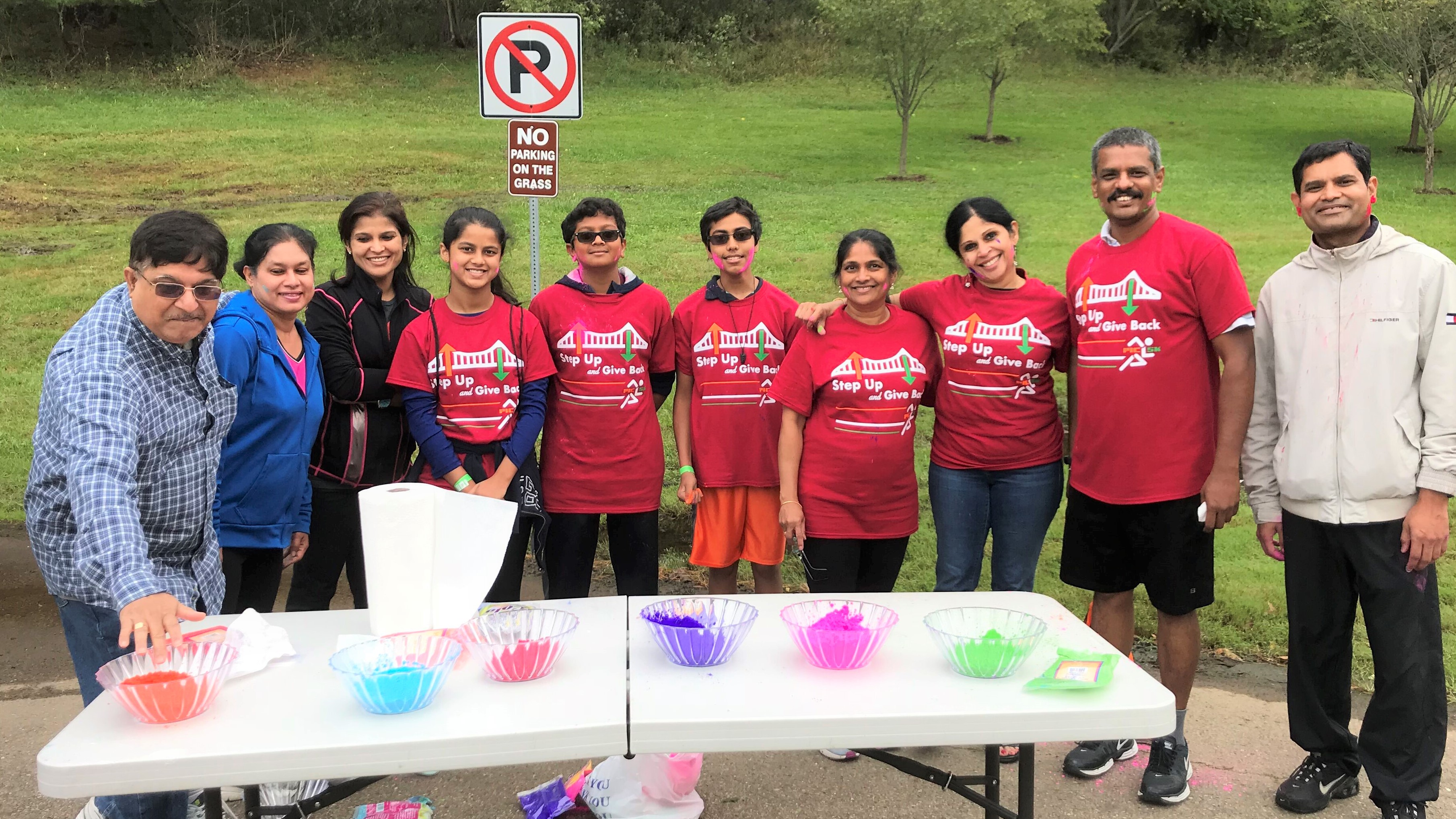
Some of the volunteers in the PIC-5k Event.
straightforward: to try to make a huge impact in the lives of people in the region where we live, work, study, and raise our families through a fun-loving fundraising event in the fall. All the money raised through donations in this annual event goes to nonprofits. Volunteers cover all the operational costs.
These last five years, PIC-5K has raised about $250,000, including the operational costs that are covered by volunteers who run this unique event. Thanks to the generosity of donors and the frugal approach of the organizing volunteers, this year, PIC-5K raised nearly $58,000 in the September 22 event. And the organizers will distribute the $58,000 raised in the event to various community organizations.
Great efforts go to due diligence for identifying, vetting and selecting the non-profits in the
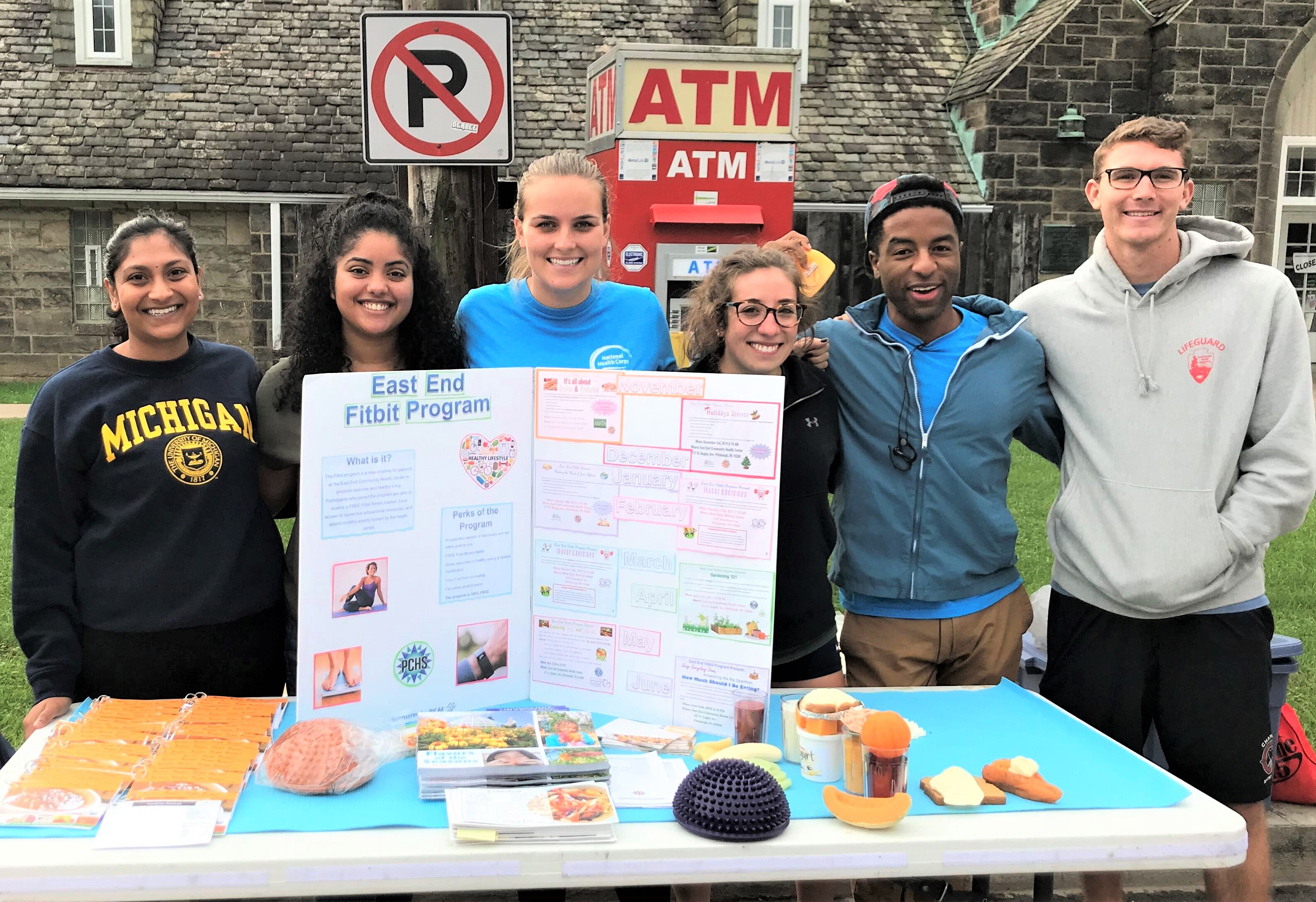
      Volunteers at the East End FitBit Program booth.
Greater Pittsburgh area mitigating homelessness, helping with healthcare and education for the needy, and emergency first responders. We request award recipients to use all the funds we donate to deliver programs to the deserving individuals in our region. We try to ensure that the recipients of our funds follow-through by requesting outcome-based reports following our funding guidelines.
You have helped us make a huge impact over the last four years and it shows! With your help we have impacted many local programs including but not limited to:
- After-school education program that helped 525 homeless children
- Nutrition program targeting low-income families
- Helping adults finish high school
- Exposing 500 underserved girls to arts and culture
- Mobile employment training to homeless people
- Setting up computers for use by the homeless
- Shoot, Don’t Shoot VR training program for 900 Police officers
- Book donations for underprivileged children.
PIC-5K’s community investments from fund raised in 2018:
- Mary’s Market Program, a stop-gap food pantry for the needy
- Home Again Program for moving homeless to their next home
- AP/EA Program to bridge the gap of textbooks for needy students
- Mother & Son Program to bring them together and make them more responsible and successful
- Additional incremental funding for Backdraft Simulator
- Books for needy children
So, PIC-5K needs you in the walkathon event, and also your material support in 2019! Next year’s PIC-5K event will be on September 14, 2019. Looking forward to seeing you there!!  ♠
Home:
Akshaya Kumar: A Pittsburgh Native Working for U.N.’s Human Rights Watch
Posted by admin in January 2019, Past issues on January 19, 2019
By Rashi Venkataraman, Washington DC       Rashi1220@gmail.com
Editor’s Note: This spring, Rashi Venkataraman, a native of Murrysville, PA talked to Akshaya Kumar, the Deputy UN Director for Human Rights Watch in Washington. A graduate from Upper St. Clair, Akshaya attended George Washington University and then earned her law degree from Columbia University. Her academic and professional work has taken her to London, Egypt, Sudan and South Sudan. Akshaya Kumar currently lives in New York City with her husband. Rashi went to Franklin Regional High School and earned her BS and MS from Carnegie Mellon University. She spent a year in Indonesia as a Fulbright Scholar. After working for the Veterans Administration for several years in different capacities, she now works for a nonprofit outfit in the healthcare-related field.
Rashi: Tell me a little bit about your current role.
Kumar: Since 2015, I’ve worked for Human Rights Watch, one of the largest human rights organizations in the world. Human Rights Watch is focused on reporting and shedding light on human rights conditions around the world. The United Nations has the power and authority to affect and address human rights in many parts of the world, and my role is focused on helping the UN do their job better.
Rashi: Since the administration change in the US in 2016, what are the biggest challenges you face doing your work in 2018?
Kumar: One of the great things about the Human Rights Watch is that our work has never solely relied on the United States as a vehicle for positive change in the world. More broadly, the United Nations is based on the principle of nations coming together from all over the world to inspire change. While there are disagreements about what that change might look like, there’s a shared sense of principles and intentions. And it’s in that shared spirit of trying to do the right thing to improve peoples’ lives that we are able to work with our counterparts at the UN on different initiatives.
Rashi: Beyond the standard accomplishments question, what is the coolest project you’ve worked on?
Akshaya: Well, the one that probably excited my family in India the most is the Op-Ed piece in the New York Times I co-authored with George Clooney and John Prendergast. It was great to shed light on the conflict in Darfur. It’s great when you can harness the power of celebrity to shed light on an important topic.
Rashi: What advice would you give young Indian-Americans growing up in Pittsburgh that might be interested in your career track?
Kumar: Pittsburgh can feel like a small town when you’re growing up and interested in international affairs. I didn’t even know a job like this existed when I grew up in Pittsburgh! There’s no reason to feel like you have to operate in a certain lane. I went to law school and got my law degree, but you don’t have to practice law if you don’t want to; there are ample opportunities to take that legal training to create your own niche. I’ve found that my law background and training has been a great foundation for doing the international justice work that is my passion.
Rashi:Â What do you miss most about Pittsburgh?
Kumar: I left Pittsburgh about fifteen years ago when I left to pursue my degree in Washington, DC. Further academic pursuits and jobs have taken me to New York, London, Egypt, Sudan, and South Sudan. When I think about growing up in Pittsburgh, I think of the tight-knit Indian community there that had so many common experiences to really bind us all together. I definitely miss the familiarity of seeing the same families at the temple during the weekend; it really fostered the sense that we were all part of a community. I’ll always feel really grateful for that and look forward to paying that forward to future generations.   ♠
Home:
My Experiment with Really, Really Cold Showers
Posted by admin in January 2019, Past issues on January 19, 2019
By Kollengode S Venkataraman      ThePatrika@aol.comÂ
Like everybody else, I have done my share of crazy things in life — like getting married, as most people have done. If that was not enough, I went to graduate school for over four years in my 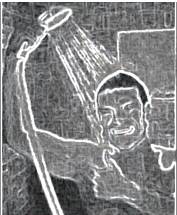 30s with a wife and a newborn baby. This was after an eight-year gap after my bachelor’s, a long gap in which my grasp of the sciences and mathematics had evaporated.
30s with a wife and a newborn baby. This was after an eight-year gap after my bachelor’s, a long gap in which my grasp of the sciences and mathematics had evaporated.
Then, in my 40s, over two decades ago, I started this magazine while holding on to a full-time job — with no experience whatsoever in editing, proofreading, or copyediting; software skills for myriad things, Bulk Mailing, selling ads, bookkeeping… … And this when my older daughter was getting ready to go to college.
Ignorance was bliss.
What have these to do with Cold Showers?†You may wonder. But this preface sets the stage for what follows. Out of necessity, I use the Internet for fact-checking, etymology of words… In this, I’ve come across nuggets of fascinating information. This is identical to the story in Yoga Vaasishtha of a man assiduously searching for a lost copper penny, fortuitously ending up with Chintamani, the wish fulfilling gemstone. But in my search, I am content if I get a nugget, if I get anything at all.
The one I got was on the health benefits of Cold Showers, defined as taking bath in really, really cold waters, at temperatures going as low as 50 F or lower. The health benefits claimed are many, some psychosomatic, others physiological: reduced stress, better alertness, long-term weight loss when done daily, increased testosterone and sperm count, better immune resistance and blood circulation, antidote for depression, better sleep, muscle recovery after injury, better skin and hair… All kinds of information is available on the Internet. Samples:
Scientific Evidence-Based Effects of Hydrotherapy on Various Systems of the Body by A Mooventhan and L Nivethitha (www.ncbi.nlm.nih.gov/pmc/articles/PMC4049052).
Here is a website on the subject: www.coldshowers.com
Here is another: www.medicaldaily.com/benefits-cold-showers-7-reasons-why-taking-cool-showers-good-your-health-289524
These are only the tip of the iceberg floating on cold waters. Also, I have seen sadhus in India taking bath in very cold flowing rivers. I attributed it to their Yogic power for many. And ganja for others, because I remember reading somewhere years ago that ganja and other addictive mind-altering substances help their users to temporarily become insensitive to their stressful situations and their immediate environs.
I was skeptical, but when I learned more, my curiosity got the better of me. I wanted to try Cold Showers, not in summer, not in fall, but in this winter, when the outside temperatures were in the 30s F (~ 0 C).
Being used to hot showers, I wondered where to begin and how. The best advice was to phase myself into it. So this is what I did, step by step:
Note: I am in my 60s and what follows worked for me, though my wife thinks I am crazy. So, after reading this, if you want to be adventurous, talk to your doctor before you start.
- On the first day, before my bath time, I indulged in some serious autosuggestion to get ready mentally. I told myself, “Venkat, after all, you’ve survived forty years of marriage; you went to grad school after a big gap, when you were married and had a baby; you’ve seen two daughters through their teen years. You have seen far worse. Cold Showers can not be any worse. Besides, it is going to be very brief, only for several minutes.â€Â Getting mentally prepared is necessary.
- Then, instead of starting with hot water (~120 F, or ~ 50 C, for me), I started with lukewarm water (~105 F, or 40 C). While under the showers at this lukewarm water, I scrubbed my body head to toe with a washcloth.
- Then, while under the shower, very, very slowly I lowered the water temperature. I stayed there for about 30 seconds, turning around, completely drenching my head, shoulder, back, legs, and front so that my entire body got used to the lower temperature. This is important.
- I lowered the water temperature again — again very gently — and drenched my entire body for 30 seconds to get used to the water.
- I took the water temperature down like this over 6 to 7 minutes.
Our normal body temperature is 98.4 F, or 37 C). So, as the water temperature came close to this, the sense of warmth I experienced vanished.
Then the fun started. When the water temperature was slightly below body temperature (around 92 F, or 33 C), I had the first sense of discomfort. I told myself to get used to the discomfort. I stayed at the lower temperatures for 30 seconds, turning around for my entire body to get used 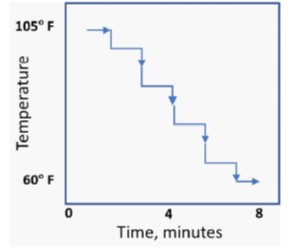 to the colder water. Surprisingly, I got used to it, and I felt OK.
to the colder water. Surprisingly, I got used to it, and I felt OK.
Then, I made the water colder by one more small decrement. I went through the cycle of experience. As the water got colder, I had a initial discomfort for each step down, but I got used to it. Strangely, I even felt a sense of mild exhilaration. The temperature-time profile was something like shown in the sketch on the side.
Then, as the temperature got colder (in the 70s F or 20s C , much colder than 98.4 F, or 37 C), the initial discomfort became acute. I was gasping for breath, breathing deeply and more frequently. But I got used to this too after 30 seconds, till the temperature was low and the discomfort was unbearable. This was my lower temperature limit for that day. Along the way, I screamed with choicest profanities in Tamil, Malayalam, English and Hindi, even Kannada, them language of my early childhood in Coorg, Karnataka. After the showers, I completely dried myself.
During this whole sequence, I was fully alert, living every millisecond in the ETERNAL NOW. At the lowest temperatures, five seconds seemed like eternity. I was mentally detached and unconcerned from everything else, simply because, honestly, I could not think of anything else. Believe me, five seconds seemed an eternity at the lowest temperature limit.
After my shower, I felt incredibly fresh and energetic. I was exhilarated, almost euphoric for no reason. Strangely, paradoxically, and contrary to my fear, I felt a great sense of warmth in my body. I did not feel cold at all. I am sure there are physiological explanations for this in terms of blood circulation, better use of oxygen through diaphragmatic breathing, and hormone secretions…
there are physiological explanations for this in terms of blood circulation, better use of oxygen through diaphragmatic breathing, and hormone secretions…
With each passing day, I lowered my bottom temperature a little. I am now around 50s F or 10 C, for over a month . I intend to stay on this for several months. My goal is to go all the way to ~40 F. I don’t know if I can reach there though.
In any case, getting used to Cold Showers is not as difficult as it appeared to me before I started, and perhaps it is not as intimidating as it appears to you from outside. It is just a matter of mind over matter. But that is what Yogic power is supposed to give to its practitioners. But it certainly does NOT need ganja or other mind-altering substances!!!!!
I already saw another benefit: My wife, who showers after me, now does not complain about not having enough hot water for her shower, and we no longer have disruptive behavior towards each other!!!!
I am in my 60s, and Cold Shower worked for me so far. But then, I’ve done many crazy things in life. So, if you want to try this, talk to your doctor first. The experience — the sense of exhilaration, energy, euphoria and the sense of well-being that stays for hours — is worth it. You will help reduce the carbon footprint, too.    ♠
Home:
Chinmaya Mission Organizes Chinmayananda’s Mahasamadhi Day in 2019
Posted by admin in January 2019, Past issues on January 19, 2019
Ganesh Krishnamurthy               ganeshk76@yahoo.com Â
Regional Coordinator, Chinmaya Mission Pittsburgh
He was waiting, searching and looking to strike. This was the mighty and powerful monkey king Vaali of Kishkinda. He was looking to defeat and destroy Sugreeva, his younger brother. A small misunderstanding was the cause of the enmity. Sugreeva was safely lodged in the Rishyamukha mountains on the outskirts of Kishkinda, because Vaali had a curse that he would drop dead if he set foot anywhere near Rishyamukha, which in Sanskrit means the abode for many Rishis and their ashrams.
Sanatana Dharma or Hinduism is replete with beautiful symbolisms from our sacred texts. In this case, Sugreeva is our individual identity or ‘Jiva.’ The terrible Vaali signifies distractions of the world’s negative forces acting on us. Rishyamukha signifies ‘Satsang’ or the company of pure-hearted and learned people to help us attain ‘moksha’ or freedom from the ill-effects of worldly distractions.
This also is a subtle pointer that the only cure for the maladies of the world is spiritual education. Individuals are the thread woven to make the fabric of the community, society, country and ultimately humanity.
One of the foremost modern Vedantic masters, Swami Chinmayananda, said, “Worldly problems can be solved only by spiritual solutions.†The Swamiji, through the Chinmaya Mission he founded, dedicated his entire life for imparting spirituality to people’s lives through Gnyana Yagnyas and Spiritual camps. He emphasized the balance of head and heart, pointing out selfless work, study and meditation as the cornerstones of life. To celebrate the life and teachings of this ‘second Vivekananda,’ the Mission organizes an annual ‘Chinmaya Mahasamadhi camp’ for the entire family.
In 2019, Pittsburgh’s Chinmaya mission hosts the camp from July 29 to August 4, 2019. Children will be in Balavihar classes and fun activities in the camp while adults get to be in Satsang, mingle with like-minded people in a Sattvik ambience. The topics covered in the camp will be on ‘Sri Krishna Leela,’ Ramayana and the Bhagavad Gita.
For registration and other details, visit www.Mahasamadhi2019.org. Please register to take advantage of the early-bird registration. There is also an option to spread the payments over six months.
We in Pittsburgh have a divine opportunity to engage in this week-long spiritual retreat/camp/festival. We hope that everyone takes advantage of this and extends their support, because remember — “He is waiting, searching and looking to strike.â€Â  ♠
Home:
“To Lend A Helping Hand, All You Need to Do Is Stretch Out Your Hand for Henna!â€
Posted by admin in January 2019, Past issues on January 19, 2019
By Priya Matreja, McDonald, PA
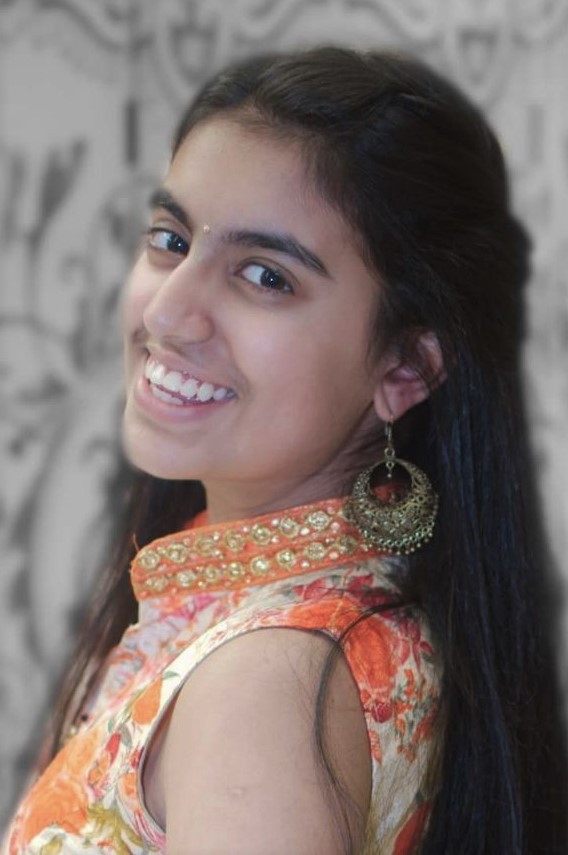
Priya Matreja
For a girl my age — I am fifteen — I feel incredibly lucky to get opportunities to promote Indian culture with my henna skills and be able to raise funds for charity.
Hello, I am Priya Matreja, a sophomore at South Fayette High School. Along with school work, I participate in extracurricular activities, Indian classical dance, and volunteer at various places. But I never hesitate to spare time even on a school night for raising funds for charity with my henna skills. You may wonder how I learned my henna skills.
I casually tried to decorate my hands using henna by watching videos on YouTube in 2016.
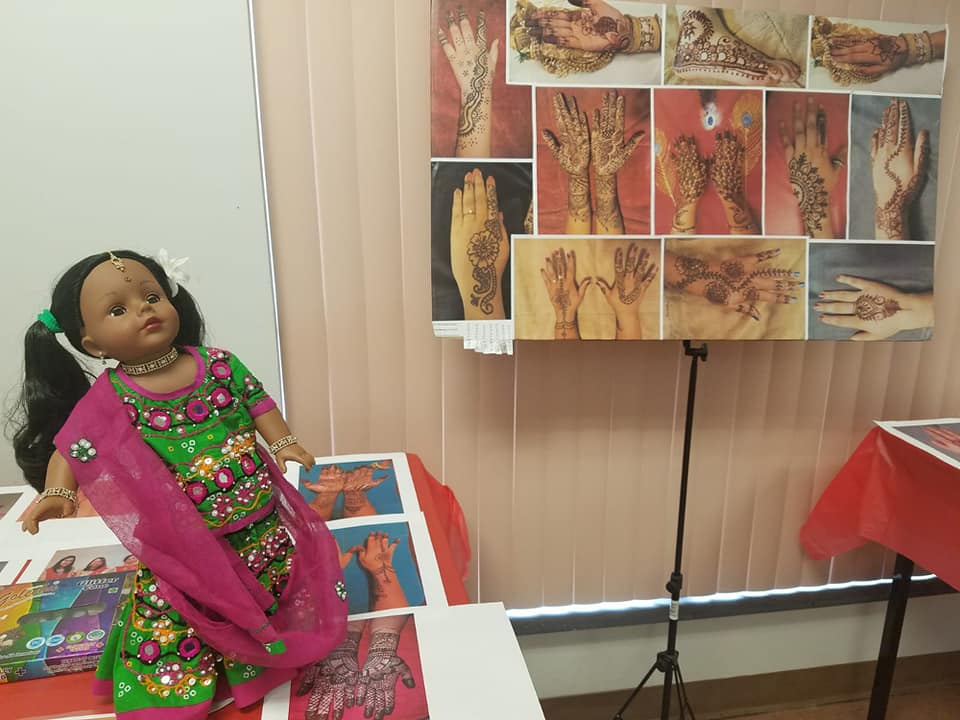
Display in a local library.
Slowly I started getting interested in the art and kept practicing it on my sister’s hands and sketch papers. It was not very long before I decided to make my passion a way to raise money.
Well, what exactly is henna? Henna, also known as mehndi, is an herbal plant-based paste used to decorate hands and feet and other parts of the human body with beautiful designs. These gorgeous designs last from about a few days to a little over a week. It takes a lot of effort to create even one design. First, I must practice multiple times before I present it to customers.
Doing henna also requires immense patience because the lines do not always come out the way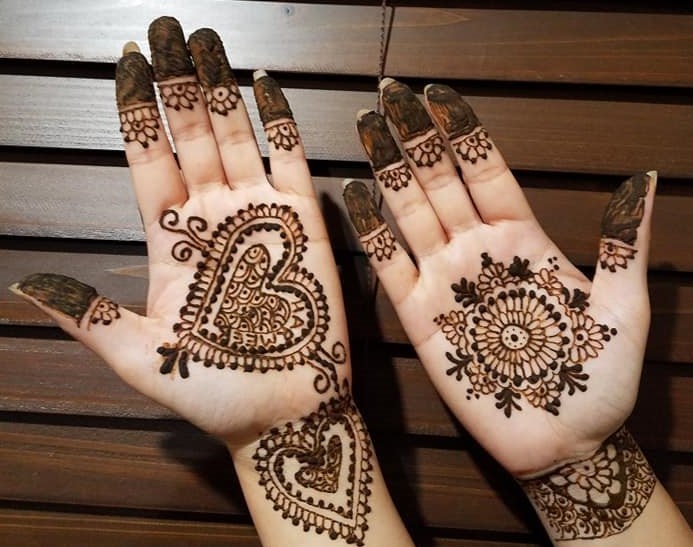 you want them to. Further, to do any design, you must sit for hours creating the design while keeping the customer from moving and ruining the pattern. My henna designs are shown here.
you want them to. Further, to do any design, you must sit for hours creating the design while keeping the customer from moving and ruining the pattern. My henna designs are shown here.
I have spent countless hours applying henna tattoos during Ganesh Chaturti, Teej, Karwa Chauth, Navaratri, Deepavali, and other functions. I also raised money through events such as “Asha†of Nandanik Dance Troupe and Durga Pooja of the Bengali Association of Pittsburgh.
I also demonstrate my henna skills, share information about it, and create awareness about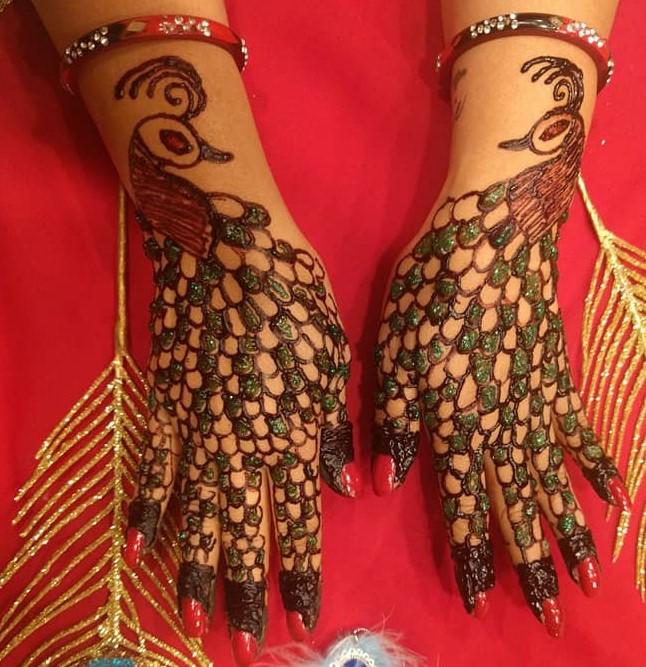 Indian culture in various places. I was given the opportunity to present my henna designs at the South Fayette Township Library’s launch event for cultural awareness, featuring a new doll named Sundari. It’s gratifying to see the amazement on peoples’ faces when they find the variety of beautiful designs and discover how easy and pain-free it is to get the henna tattoo done with mehndi.It gives me great satisfaction when I donate everything that I earn. So far, I have raised about $400 towards
Indian culture in various places. I was given the opportunity to present my henna designs at the South Fayette Township Library’s launch event for cultural awareness, featuring a new doll named Sundari. It’s gratifying to see the amazement on peoples’ faces when they find the variety of beautiful designs and discover how easy and pain-free it is to get the henna tattoo done with mehndi.It gives me great satisfaction when I donate everything that I earn. So far, I have raised about $400 towards 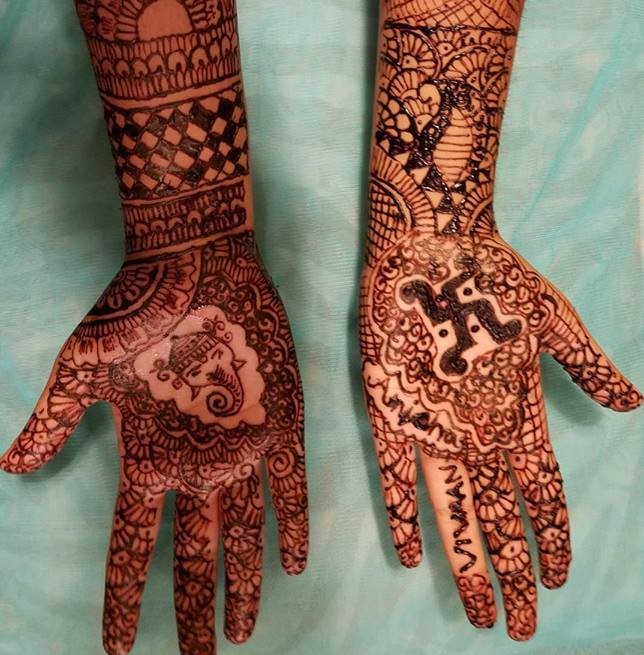 the Kerala Flood Relief fund, the KDKA Turkey Fund (which provides Thanksgiving meals to the needy), Toys for Tots (which gives Christmas gifts to kids who cannot afford them) and others.
the Kerala Flood Relief fund, the KDKA Turkey Fund (which provides Thanksgiving meals to the needy), Toys for Tots (which gives Christmas gifts to kids who cannot afford them) and others.
I think I have made significant progress in my journey as a henna artist, thanks to all my patrons who have encouraged me to come this far. I hope to continue this, because I realize that there are always innovative ways to help mankind.
One of the members of the Bengali Association of Pittsburgh helped me come up with a quote for my endeavor “To lend a helping hand, all you need to do is stretch out your hand for henna.â€
The henna designs shown here are my creations.  My request to all my readers is to consider me for their henna needs in the future to support my endeavor. Thank you. Jai Hind!! God bless America!!   ♠
Home:
The Hindu-Jain Alliance’s Inter-Faith Gathering Against Religious Hatred
Posted by admin in January 2019, Past issues on January 19, 2019
By Premlata Venkataraman      Thepatrika@aol.com
The Hindu and Jain Alliance of Greater Pittsburgh, a newly formed group of Hindu and Jain organizations here, held a well-attended — and well-organized — Interfaith gathering at the Sri Venkateswara Temple on December 9, 2018. The context was the ghastly shooting spree on October 27, 2018 with eleven people shot to death by Robert Gregory Bowers, 46, a resident of Baldwin, PA, inside the Tree of Life Synagogue in Squirrel Hill. Nine of victims were over 65
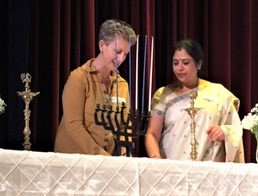
Suchitra Srinivasa helping Rabbi Symons to set up the Menorah flanked by two traditional Hindu oil lamps.
years of age and six were over 75. The theme of the event was Unity in Diversity, based on the Hindu axiom Vasudhaiva Kutumbakam (The whole earth is one family). Coming in the wake of the killings in a synagogue, the theme was poignant.
The participants were Rev. Liddy Barlow (Christian Associates of Southwest Pennsylvania), Mr. Wasi Mohamed (The Islamic Center of Pittsburgh), Mr. Joshua Sayles (The Jewish Federation of Pittsburgh), Shri Som Sharma (Ahinsa), Rabbi Barbara Symons (Temple David), Acharya Vivek (The Chinmaya Mission), and Rev De Niece Welch, (Pittsburgh Interfaith Impact Network).
Two traditional Indian oil lamps flanking the menorah set the mood for the gathering at the temple auditorium. The priest Shri Venkatacharyulu lit the Indian lamps to begin the meeting, as Barbara Symons solemnly read the names of those killed in the shooting spree at the Squirrel Hill synagogue, following which Hindu priests recited Shanti Mantras. The English translations of the mantras were projected on a screen so that the invited guests and the audience could internalize the lofty messages of the mantras. This was a welcome change.
Next Harichandan Mantripragada conducted a brief session of traditional meditation to focus our thoughts on bringing peace within us.
Since it was Hanukkah, members of the Jewish faith lit the menorah amid Jewish prayers in Hebrew. It was a profound moment for the audience to listen to Hebrew prayers and Sanskrit hymns for the peace.
Many members of the various faiths gave messages of peace and unity. The Rev. Liddy Barlow gave a Christian reading emphasizing that we do not have to be identical to coexist.
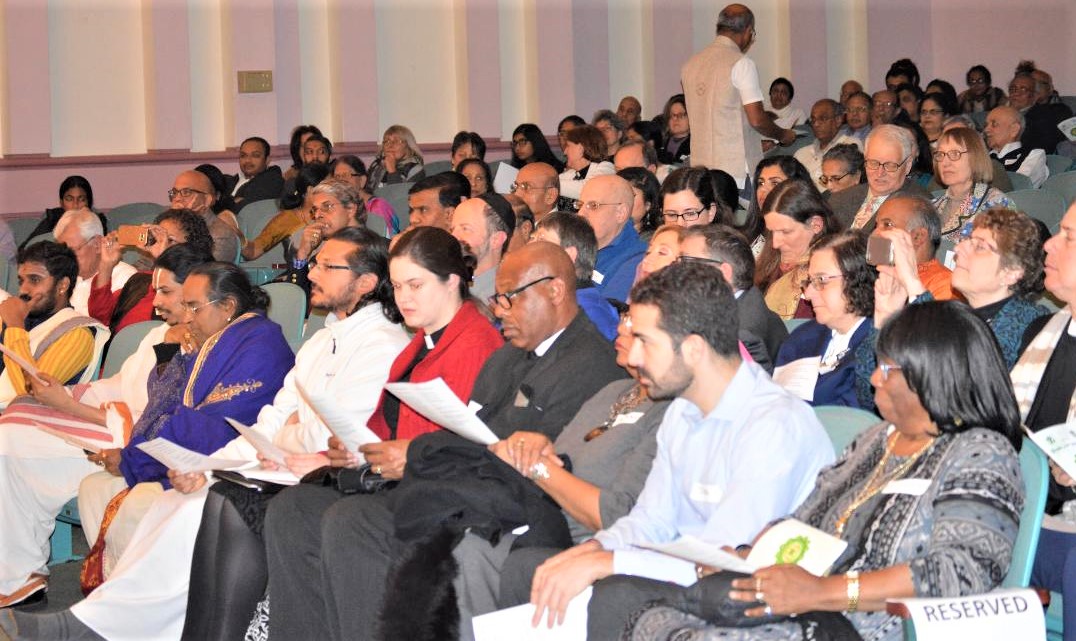
The gathering for the event at the auditorium.
Som Sharma, who for several decades, represented Hindus in many interfaith gatherings inour area, drew on the universal teachings of the Isavasya Upanishads and the Hindu tenet that all streams of the various faiths ultimately lead to Brahman or the Supreme One. The Rev DeNiece Welch echoed the same theme from the Christian perspective: since we are created in God’s image, we should find His likeness in all the differences we find among all of humanity and hence never give into hatred.
Joshua Sayles from the Jewish Federation touched everyone when he said he will
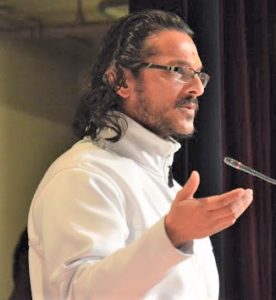
Acharya Vivekji addressing the gathering summarizing the highlights of other speakers.
never ever forget his experience of celebrating Hanukkah at a Hindu temple with people of all faiths in attendance. The hateful events leading to the mindless carnage of the innocents at the Tree of Life may still happen again in other places, he said. But it has brought all of us together in support, so we can become strong again, he said, thus showing us a silver lining in an otherwise mass of dark clouds.
Chinmaya Mission’s Acharya Vivek, who came  from Niagara, Canada, spoke last and summed up the key points of all the speakers who preceded him. He emphasized that individuals working together to understand each other help to remove ignorance and eliminate blind hatred that ends in violence like that happened at Tree of Life.
Law enforcement officials from the Penn Hills and Monroeville municipalities were present at the gathering. Doug Cole, Monroeville municipality’s Chief of Police, told the audience that events like this go a long way to bring communities together.
It was noteworthy that the minimal, but appropriate comments by the two emcees, Nangali Srinivasa and Visala Muluk, enhanced the solemnness of the occasion, as did the translations of the Sanskrit hymns recited.  ♠
Home:
Court-Ordered Redistricting Maps Make Our Congressional Delegation Equitable
Posted by admin in January 2019, Past issues on January 19, 2019
By Kollengode S Venkataraman ThePatrika@aol.com
The midterm elections last November set right the perversion of democracy in Pennsylvania by the GOP-controlled state legislature. In recent decades, the GOP-controlled General Assembly in Harrisburg, after the decennial census, had redrawn congressional district maps. This is mandated by law. However, the GOP in the General Assembly did this in such a way as to give themselves undue advantages in the elections.
Pennsylvania is a moderate state — socially conservative but left-of-center on economic and pocket book issues. In elections for U.S. president and U.S, Senate, the vote split between Democratic and Republican candidates is 45:55 swinging either way. We have voted for both Republicans and Democrats in presidential elections; we have had both Democratic and Republican governors and U.S. Senators.
But the delegation to the U.S. House of Representatives tells a different story. It is skewed badly in favor of Republicans. In the 18-member congressional delegation from the state, the GOP/Democrat split is 13/5, giving undue weightage to Republicans. This is because of the way the GOP-controlled General Assembly in Harrisburg has drawn the maps for the congressional districts, through what is called gerrymandering. States redraw congressional district maps every ten years based on population changes. An article in the April 2018 issue discussed this at length. See here: www.tinyurl.com/Equitable-PA-House-Delegates.
Early last year, in a law suit filed by the League of Women Voters, the state Supreme Court asked outside consultants to redraw the maps to make them more representative of the voting patterns of the state. In the mid-term November elections of 2018, with the redrawn maps for the 18 Congressional districts, the GOP-Democrat split is now 9:9, more reflective of our state’s political character.
Yes, the unpopularity of Donald Trump in the White House also has contributed to this shift favoring Democrats. But even without Trump at the White House, with the redrawn map, the delegate to the US House of Representatives from the Pennsylvania would have been more equitable, more like 10/8 in favor of the GOP instead of 13/5.
Thank you, the League of Women Voters, for bringing the law suit to the Pennsylvania’s Supreme Court. Thank You, the State Supreme Court, for forcing the redrawing of the maps for Congressional districts and making it truly representative of the ethos of our citizens.
This gerrymandering is common also in Democrats-controlled states and cities, where Democrats give themselves undue advantages in elections to stage legislatures and city councils. Gerrymandering not only perverts the very idea of “Representative Democracy, but also always leads to corruption at many, many levels.
==============================================
How changes in the population of our state relative to the population of the nation affect our political clout:
The plot below encapsulates the population dynamics of our home state of Pennsylvania in relation to the population of United States.

The U.S. population has been growing quite rapidly in the last century, from 76 million in 1900, 200 million in 1920, 250 million in 1990, to 320 million in 2020. The black line in the graph. The population of the state of Pennsylvania is leveling off (blue line in the graph)we were just over 6 million in 1900, 10.5 million in 1950, over 12 million in 2000, and currently around 13 million. As a result, the population of the state as a percentage of the population of the nation has been declining (the red line in the graph). We were 8% of the nation’s population in 1900, and now we are under 4% of the nation’s population.
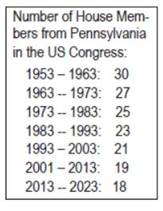
The total number of members in the US House of Representatives in the US Congress is 435, fixed by the constitution. The number of House Members in each state is based on the population of each state relative to the population of the nation. Since the population of Pennsylvania as a percentage of the U.S. population has been declining, the number of House members from Pennsylvania in the US Congress has been declining. We had 30 members in 1950s. Now, only 18. See the table.
Republicans, having a majority in our state’s General Assembly in Harrisburg for long, have skewed the redrawing the maps of the congressional districts. The split between the two party’s Congressional delegation from Pennsylvania, is nothing but a scandal.
Again, remember, Pennsylvania is a moderate state, and we have elected people from both parties to state-wide offices. And the vote split in state-wide elections are generally narrow, 55-45, swinging either way. In this background, here are the numbers of GOP and Democratic Congressmen from the state:

Thus, Republicans had 67% of the state’s 18-member Congressional Delegation to the US House, even though the state votes 45-55, swinging either way in presidential and Senate races. This gerrymandering is not unique to our state. Democrats indulge in the same perversion where they are in majority
Finally, with the state Supreme Court’s order for redrawing the maps, in the midterm elections in November 2018, the split in the 18-member Congressional delegation is 9/9. ♠

